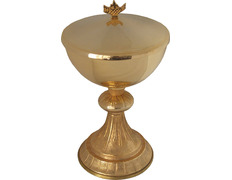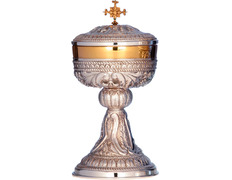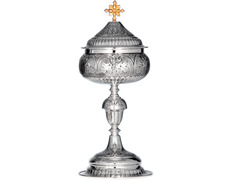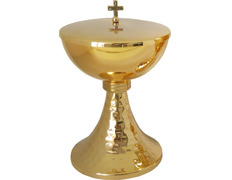The ciboria, along with chalices and patens, are the three most important pieces of goldsmithing during the Eucharist. Their main purpose is to serve as a receptacle for the species that will become the Body and Blood of Christ during the liturgical celebration.
The ciborium, as its name suggests, is a large cup that is included among the sacred vessels of the Catholic Church.
The main function of the ciborium is to hold the Sacred Hosts to give to those who wish to receive Communion. It is essential to note that this sacred vessel holds the Body of Christ during this process.
The ciborium usually has a shape very similar to chalices but with several particularities.
It is common for ciboria to be slightly wider than chalices. A larger size allows ciboria to hold a greater number of Sacred Hosts. The larger the diameter, the greater the capacity of a ciborium.
The purpose of ciboria is to serve as a container for consecrated Hosts so that the priest can offer them to the faithful. Considering this, it is important that the cup of the ciborium, the upper part, is not too tall to facilitate taking and offering the Sacred Forms.
One of the main differences between ciboria and chalices is that the former often come with a lid that prevents environmental impurities from coming into contact with the consecrated Hosts.
The lids of ciboria frequently have a decoration similar to the cup. Additionally, they are generally topped with a Cross that serves as a decorative element and as a handle to easily manage the lid.
Ciboria, as sacred vessels that safeguard the Blessed Sacrament, must be made from specific materials worthy of this function.
It is common to use gold chalices, silver chalices, or bronze chalices because they are noble materials, materials of high quality.
Another option is to make them from other materials such as brass, metal, etc., with the cup's interior having a gold-colored or silver plating that dignifies the surface where the Blessed Sacrament will rest.
The Catholic ciboria, also known as pyxes or ciboria, are sacred vessels used in the Eucharist, during Mass | Ciboria are used to store the Blessed Sacrament | There is a wide variety of materials used in the manufacture of pyxes. In our online store, we have available silver ciboria, bronze ciboria, metal ciboria, etc.
Below, you can see a wide variety of liturgical ciboria at the best purchase prices.

Ref: 65F110

Ref: 1F1104

Ref: 94F10722

Ref: 94F10736

Ref: 94F10743

Ref: 94F10720

Ref: 94F10313

Ref: 0F12010CO

Ref: 0F12010CO

Ref: 1F876

Ref: 0F12012CO

Ref: 1F813

Ref: 1F632

Ref: 1F342

Ref: 1F1088

Ref: 1F173

Ref: 1F100

Ref: 1F186

Ref: 1F184

Ref: 94F10721

Ref: 94F10807

Ref: 1F187

Ref: 1F692

Ref: 1F692

Ref: 1F798

Ref: 1F798

Ref: 0F12010CO

Ref: 1F684P

Ref: 25FBA201

Ref: 65F1101PBO

Ref: 25FAA301

Ref: 25FAA302

Ref: 25FAA303

Ref: 25FAA304

Ref: 25FAA305

Ref: 25FAA306

Ref: 25FAA307

Ref: 25FAA308

Ref: 25FAA309

Ref: 25FAA310

Ref: 25FAA311

Ref: 25FAA312

Ref: 25FAA313

Ref: 25FAA314

Ref: 25FAA315

Ref: 25FAA316

Ref: 25FAA317

Ref: 25FAA318

Ref: 25FAA319

Ref: 25FAA320

Ref: 25FAA321

Ref: 25FAA322

Ref: 25FAA323

Ref: 25FAA324

Ref: 25FAA325

Ref: 25FAA326

Ref: 94F32721

Ref: 94F32716

Ref: 94F10132M

Ref: 1F611

Ref: 1F615

Ref: 94F10644

Ref: 25FAA327

Ref: 1F699

Ref: 1F808

Ref: 1F145

Ref: 1F009

Ref: 1F795

Ref: 65F1101